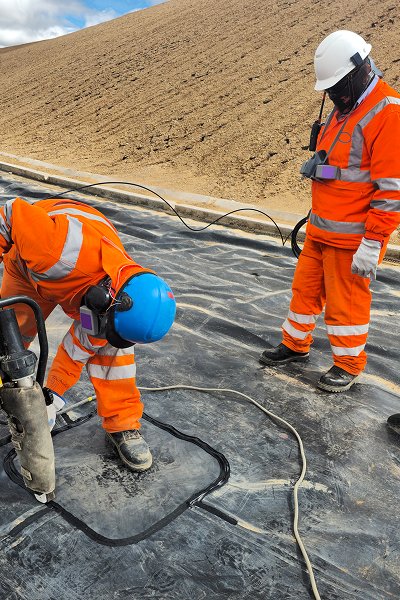-
Geotube
-
Geogrid
-
Nonwoven Geotextile
-
Woven Geotexitle
-
Nonwoven Geo Bag
-
Geosynthetics Clay Liner
-
Anti Grass Cloth
-
Plastic Grass Grid
-
Drainage Board
-
Adjustable Pedestal
-
Composite Geomembrane
-
Tarpaulin
-
Drainage Cell
-
Road Crack Sealing Tape
-
Geographic Grid
-
Geomembrane welding machine
-
Three Dimensional Geomat
-
Composite Geonet
-
Asphalt cold patch
-
HDPE Geocell
-
Geomembrane






Geotube has been widely used in coastal protection, port dredging, tailings dewatering, sludge treatment, river regulation and other fields, and is currently the world's mainstream sustainable seepage prevention and dewatering technology solution.
Geotube specifications
Item | Test Standard | Unit | Technical Data | ||||||
Material | Polypropylene With Black or Sand Color | ||||||||
Spec | HT50 | HT70 | HT90 | HT105 | HT120 | HT200 | |||
Tensile Strength | MD | ASTM D4595 | KN/M | 50 | 70 | 90 | 105 | 120 | 200 |
CD | ASTM D4595 | KN/M | 50 | 95 | 120 | 105 | 120 | 200 | |
Elongation | MD/CD | ASTM D4595 | % | 10,11,12,13,15 | |||||
Opening Size O90 | mm | 0.05-0.90 or Customized | |||||||
Length | m | 20,30,50,100m | |||||||
Circumference | m | 5-20m | |||||||
Key Features & Advantages
High-Strength Structure
Made of high-strength polypropylene (PP) or polyester (PET) woven fabric, with a tight weave and tensile strength of 100–200 kN/m.
Ensuring shape stability during filling and dewatering, preventing tearing or bursting.
Superior Dewatering Performance
Selected permeable pore size (0.2–0.6 mm) allows for rapid drainage of clean water, increasing solids content.
Suitable for use with polymeric flocculants (PAM) to improve dewatering efficiency.
Excellent Weather Resistance and UV Resistance
Resistant to seawater, acids, alkalis, and UV radiation, suitable for long-term outdoor exposure.
Simple Construction and Reusable
No complex machinery required; ready for use after on-site filling.
After dewatering, it can be used as part of dams, revetments, or foundation structures.
Environmentally Friendly and Energy-Saving
An alternative to traditional dewatering tanks and filter presses, saving space, reducing energy consumption, and minimizing secondary pollution.
Applications
Coastal and River Protection: Erosion prevention, bank reinforcement, seawall construction, land reclamation.
Dredging and Dewatering Engineering: Dewatering and solid waste disposal in ports, lakes, and rivers.
Tailure and Industrial Sludge Treatment: Suitable for dewatering mine tailings slurry, paper mill sludge, and municipal sludge.
Environmental Protection and Solid Waste Treatment: Can be used as an environmentally friendly dewatering container to achieve sludge reduction and solidification.


Customization Services:
Customized Specifications: We can customize weight, thickness, width, and length based on your needs.
Customized Packaging: We can customize packaging options such as wrapping and palletizing.




Installation Guide
Site Preparation: Clean the foundation and lay the geotube or geomembrane.
Geotube Positioning: Arrange the geotubes according to the design drawings, ensuring a tight seal at the joints.
Pumping the Packing Material: Use a mud pump to fill the geotubes with water-containing solids.
Dewatering Process: Allow to stand for several hours to several days, depending on the environment and material characteristics.
Repeated Filling: Can be repeatedly filled to the design height.
Final Treatment: After dewatering, the geotubes can be covered with soil on-site or transported for reuse.
FAQ
What is a geotube bag?
A: A geotube bag is a large tubular structure made of high-strength geotextile (such as polypropylene or polyester). It is commonly used in projects such as sludge dewatering, coastal protection, cofferdams, and solid waste containment. After being filled with slurry or mortar, water is discharged through the filter cloth while the solids remain inside the bag, achieving consolidation and reinforcement.
How do geotextile tube bags achieve dehydration and consolidation?
A: Geotextiles have excellent water permeability. When slurry is pumped into the bag, water quickly seeps out, while fine particles and solid matter are retained inside, gradually dehydrating, compressing, and forming. Flocculants can be used in conjunction with the bag to accelerate dehydration and improve dehydration results.
What is the service life of geotube bags?
A: Depending on the project type and environmental conditions, the service life can range from a few years to over ten years. If exposed to sunlight, it is recommended to use a UV-resistant coating or cover to extend the life. In landfill projects, the service life can reach over 20 years.
Can geotubes be reused?
A: For non-permanent projects (such as temporary cofferdams), geotubes that have been inspected and found to be undamaged can be reused multiple times. However, for one-time solid waste encapsulation or permanent containment projects, the tubes are typically used only once to ensure sealing and structural integrity.
 High-strength dewatered geotube | Erosion control and sludge dewatering solutions
High-strength dewatered geotube | Erosion control and sludge dewatering solutions
We specialize in manufacturing high-strength Geotube geotextile bags for coastal protection, river dredging and dewatering, tailings treatment, and dam reinforcement. Custom sizes and materials are available.
 Geotube
Geotube
Geotube, also known as geotextile tube bag, Geotube, dewatering bag, is a large tubular structure made of high-strength synthetic fiber (such as PP, PET), widely used in dam reinforcement, coastal protection, sludge dewatering and reclamation projects. By filling slurry containing solid waste or sludge, using its filtering and drainage, consolidation and drainage separation functions, the reinforcement, dewatering, bank protection and other engineering goals are achieved.


